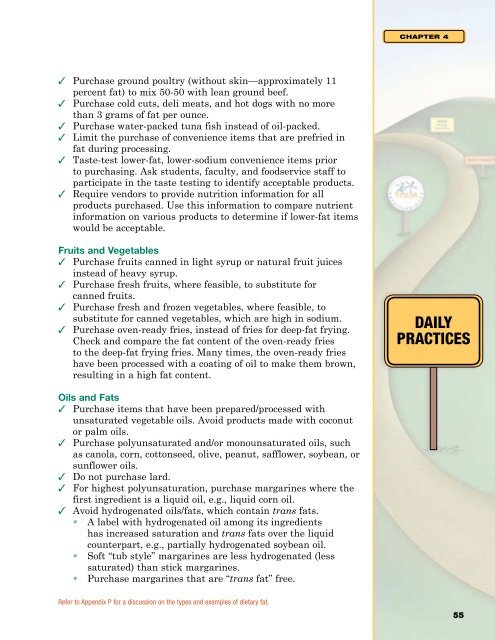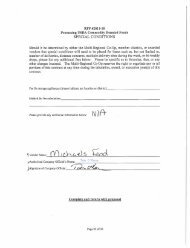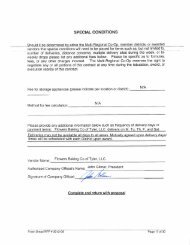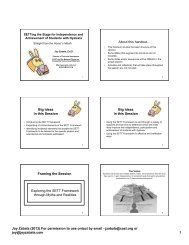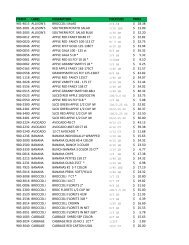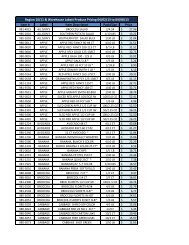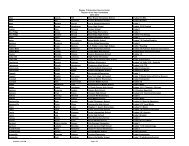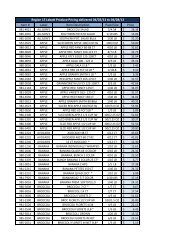Road to SMI Success Manual - Region 10 Education Service Center
Road to SMI Success Manual - Region 10 Education Service Center
Road to SMI Success Manual - Region 10 Education Service Center
You also want an ePaper? Increase the reach of your titles
YUMPU automatically turns print PDFs into web optimized ePapers that Google loves.
Chapter 4<br />
✓<br />
✓<br />
✓<br />
✓<br />
✓<br />
✓<br />
Purchase ground poultry (without skin—approximately 11<br />
percent fat) <strong>to</strong> mix 50-50 with lean ground beef.<br />
Purchase cold cuts, deli meats, and hot dogs with no more<br />
than 3 grams of fat per ounce.<br />
Purchase water-packed tuna fish instead of oil-packed.<br />
Limit the purchase of convenience items that are prefried in<br />
fat during processing.<br />
Taste-test lower-fat, lower-sodium convenience items prior<br />
<strong>to</strong> purchasing. Ask students, faculty, and foodservice staff <strong>to</strong><br />
participate in the taste testing <strong>to</strong> identify acceptable products.<br />
Require vendors <strong>to</strong> provide nutrition information for all<br />
products purchased. Use this information <strong>to</strong> compare nutrient<br />
information on various products <strong>to</strong> determine if lower-fat items<br />
would be acceptable.<br />
Fruits and Vegetables<br />
✓ Purchase fruits canned in light syrup or natural fruit juices<br />
instead of heavy syrup.<br />
✓ Purchase fresh fruits, where feasible, <strong>to</strong> substitute for<br />
canned fruits.<br />
✓ Purchase fresh and frozen vegetables, where feasible, <strong>to</strong><br />
substitute for canned vegetables, which are high in sodium.<br />
✓ Purchase oven-ready fries, instead of fries for deep-fat frying.<br />
Check and compare the fat content of the oven-ready fries<br />
<strong>to</strong> the deep-fat frying fries. Many times, the oven-ready fries<br />
have been processed with a coating of oil <strong>to</strong> make them brown,<br />
resulting in a high fat content.<br />
Daily<br />
Practices<br />
Oils and Fats<br />
✓<br />
✓<br />
✓<br />
✓<br />
✓<br />
Purchase items that have been prepared/processed with<br />
unsaturated vegetable oils. Avoid products made with coconut<br />
or palm oils.<br />
Purchase polyunsaturated and/or monounsaturated oils, such<br />
as canola, corn, cot<strong>to</strong>nseed, olive, peanut, safflower, soybean, or<br />
sunflower oils.<br />
Do not purchase lard.<br />
For highest polyunsaturation, purchase margarines where the<br />
first ingredient is a liquid oil, e.g., liquid corn oil.<br />
Avoid hydrogenated oils/fats, which contain trans fats.<br />
•<br />
•<br />
•<br />
A label with hydrogenated oil among its ingredients<br />
has increased saturation and trans fats over the liquid<br />
counterpart, e.g., partially hydrogenated soybean oil.<br />
Soft “tub style” margarines are less hydrogenated (less<br />
saturated) than stick margarines.<br />
Purchase margarines that are “trans fat” free.<br />
Refer <strong>to</strong> Appendix P for a discussion on the types and examples of dietary fat.<br />
55 55


